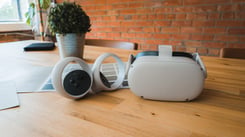We recently came to the satisfying end of an (at times slightly unsatisfying) six-month process to have Yulio listed on Daydream with our new Google Daydream App. For those who don’t know, Daydream is Google’s VR platform for Android devices that are supported by its own cool new viewer hardware, the Daydream View. Yulio’s already listed on every other major app store and therefore we can understand if this news doesn’t, at first glance, have you scrambling to share the news with all of your closest friends. However, the experience of working with the Google team - a group living and breathing the shifting world of VR and leading an impressive charge in VR for business - was notable in a few ways that we thought were worth talking about. As a little bit of background, Google introduced the Daydream platform in 2016. It was created to simplify access to high-quality virtual reality content on mobile devices and could be seen as an obvious continuation of a noble vision to put VR in the hands of everyone, started with the launch of its Cardboard viewer and associated apps.
Making the Grade
Google Daydream app listings, however, arenot open to just any content and not accessible from just any device. Currently, content can be viewed on Google’s own Pixel and Pixel XL smartphones as well as a select few newer Android devices that have chosen to meet an optimal specifications list which is not for the faint-hearted. When it comes to submitting apps, Google is equally selective and stringent on quality. Fortunately, stringent on quality is what we’re all about. Without intentionally grabbing ourselves by the cheeks and patting ourselves vigorously on the back, adhering to robust quality and verification checks is not something Yulio has ever had trouble with. Our product development team is made up of some of the best minds the VR industry has to offer and, as a result, our platform has been built from the ground up to exacting standards.
Building the Business Dream
The majority of current Daydream apps lean towards either sophisticated gaming or ‘experiential’ - by experiential, we mean, as an example, apps such as The New York Times which allows viewers to virtually embed with Iraqi forces during a battle with ISIS or, in stark contrast, take a meditation journey to the California coast. Yulio sparked a special interest in the Google team, not only was our app the first of any competitors within VR for A&D to be approved but also because it represented one of only a small handful of current Daydream apps built solely for business. This is a relatively unexplored area - even for Google - and therefore based on a large volume of data Yulio has amassed, we were able to share a few insights.
You Don’t Always Need a Magic Wand
As an example of this, as part of the standard specifications for Daydream apps, each must support the use of the handheld Daydream controller as a control method. Google’s Daydream View headset comes with a supplementary remote which doubles as a motion-sensitive tool used to point and click on objects, navigate menus, etc. In our time building Yulio we’ve tested almost every VR hardware system on the market. Those with controllers and those without, from Oculus and HTC Vives to Samsung Gears and others on the way to Google Cardboards. When it came to using controllers in business applications, we saw that they simply didn’t work well in business and presentation settings. Designers using VR to communicate a new project want more than anything to have their clients feeling relaxed and paying attention while immersed in the design. What we’d seen instead when controllers are introduced is that they often added an unnecessary and often distracting level of complexity. People more commonly felt self conscious as they fumbled with a new piece of technology while effectively blindfolded in front of their colleagues. Often it closely resembled the scene when showing a parent how to use a new TV remote - "The button on the left, tap that....no you held it too long, just tap it.” With this in mind, in an effort to make sure the Yulio app worked in the best way possible for the end users but still passed Google’s code of conduct, we created a feature allowing a controller to be put down and have it fade into the background. Users are then able to switch to gaze-to-go navigation if they prefer or use the controller if they are comfortable.
Sharing small but key insights like this with the Google team based on our ‘in the field’ experience with VR for business has been of real value, and we were delighted to see our thinking validated with our inclusion in the Google Daydream app store. Find the Yulio viewer for Daydream here and if you’re ready to try making your own VR daydreams a reality, try Yulio for free….and have your first VR experience in minutes.



.jpg?width=245&height=150&name=active-adult-beautiful-1799244%20(1).jpg)


